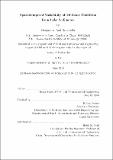Spatiotemporal variability of methane ebullition from lake sediments
Author(s)
Scandella, Benjamin P. (Benjamin Paul)
DownloadFull printable version (8.343Mb)
Other Contributors
Massachusetts Institute of Technology. Department of Civil and Environmental Engineering.
Advisor
Ruben Juanes.
Terms of use
Metadata
Show full item recordAbstract
Methane is a potent greenhouse gas, and natural sources to the atmosphere include inland waterways and shallow oceans. However, the magnitude of these emissions and their potential for feedbacks with climate change remain poorly constrained. In many settings the majority of atmospheric methane emissions is delivered by bubbles, and the spatiotemporal heterogeneity of ebullition makes measurement challenging and impacts bubble dissolution and atmospheric emissions. In this thesis, we present an analysis of both the episodicity and spatial structure of methane venting from soft sediments in a eutrophic lake over a range of spatial scales, from 1 cm to 20 m, and using a combination of field observations and laboratory experiments. Field-scale measurements of ebullition were acquired at the bottom of Upper Mystic Lake, MA, USA, using a high-resolution multibeam sonar during multiple deployments over a 9-month period. The sonar was calibrated to estimate the gas flow rates throughout a 330 m2 lateral observation area with resolution of 0.5 m. The results confirm that ebullition is strongly episodic, with distinct regimes of high- and low-flux largely controlled by changes in hydrostatic pressure. Statistical analysis shows that the spatial pattern of ebullition becomes homogeneous at the sonar's resolution over timescales of hours (for high-flux periods) or days (for low-flux periods), demonstrating that meter-scale methane vents are ephemeral rather than persistent. Laboratory-scale measurements were made in a controlled incubation of reconstituted sediments from the same field site. Image analysis of the 0.14 m2 observation area allowed identification of individual bubble outlets and resolved their location to ~ 1 cm. While ebullition events were typically concentrated in bursts lasting ~ 2 min, some major outlets showed persistent activity over the scale of days and even months. This persistence was surprising given the ephemerality of spatial structure at the field-scale. It suggests that, at the centimeter scale, conduits are re-used as a result of a drop in tensile strength due to deformation of sediments by the rising bubbles. By combining novel measurement techniques at different scales, we elucidate the mechanisms governing bubble growth and mobility, thereby supporting estimates of global methane fluxes from lakes and how their magnitude may vary with climate change.
Description
Thesis: Ph. D., Massachusetts Institute of Technology, Department of Civil and Environmental Engineering, 2016. This electronic version was submitted by the student author. The certified thesis is available in the Institute Archives and Special Collections. Cataloged from student-submitted PDF version of thesis. Includes bibliographical references (pages 130-140).
Date issued
2016Department
Massachusetts Institute of Technology. Department of Civil and Environmental EngineeringPublisher
Massachusetts Institute of Technology
Keywords
Civil and Environmental Engineering.